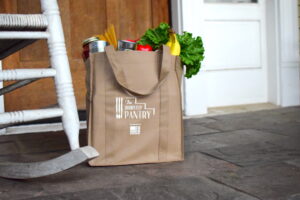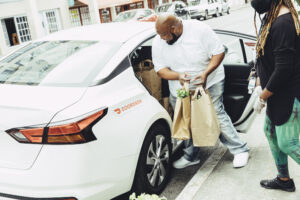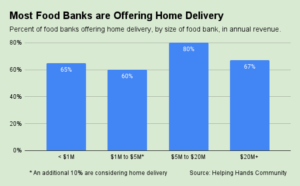Earlier this year, Food Bank News wrote about home delivery being at a crossroads. Food banks were trying to figure out if they could keep home deliveries going, even though pandemic-era aid to support the deliveries was becoming less available.
A new report from Urban Institute now offers some clarity around the issue. According to the report, food banks overwhelmingly plan to continue providing home delivery, with 83% saying they will do so. Further, 59% say they plan to expand the service. The report, funded by DoorDash, includes responses from 103 anti-hunger organizations, most of them food banks.
The results reflect the high need for home deliveries within communities, despite the many challenges of keeping them going. Ninety-three percent of anti-hunger organizations acknowledged in the report that home delivery gets food to people who otherwise would not have access, due to transportation, health or other barriers.
Home delivery flourished during the pandemic when aid to support it was flowing. By the end of 2022, for example, DoorDash was providing home delivery services to more than 300 nonprofit organizations in all 50 states. At that point, the company began meeting one-on-one with its nonprofit partners to discuss its transition away from full support toward subsidized rates that would make home delivery financially sustainable for both DoorDash and its nonprofit partners.
Those discussions forced food banks to weigh whether they could continue with a service that is so clearly needed, yet is expensive and difficult to manage. As DoorDash has transitioned away from full support, some foundations have stepped up to provide grant funding for home delivery, the report said, while government funding remains harder to come by.

Second Harvest of the Greater Valley, based in Manteca, Calif., is an example of a food bank that has eased into other funding as support from DoorDash has receded. The food bank currently delivers to 1,500 homes per week and plans to continue to do so for at least the next three years, said Keenon Krick of the food bank.
Its relationship with DoorDash during the pandemic helped grow the program from 200 to 300 deliveries per week. Now home deliveries, including the hiring of part-time drivers, are being supported by grant funding as well as the food bank’s general fundraising, Krick said. “We’ve been able to manage it.”
The deliveries go to seniors and medically fragile people, a community that is high on Krick’s radar screen, given his prior role as Executive Director of United Cerebral Palsy, he said. In addition to supporting deliveries, the food bank is building a commercial kitchen that will let it deliver prepared meals, rather than the grocery bags it currently distributes.
For many food banks, DoorDash continues to play a large role in their home-deliveries, with 45% of surveyed organizations continuing to provide home delivery exclusively through DoorDash. Those that use other methods report relying on volunteers (58%) and paid staff (10%).
Many of the delivery operations using DoorDash are modest, with the majority (55%) serving fewer than 100 people at least once a month and 34% serving between 100 and 500, the report found. Fewer than 5% of organizations are using DoorDash to deliver to more than 500 people at least monthly. Almost all the organizations prioritize serving seniors (92%), people with disabilities (85%), and people without transportation (83%).
While partnerships with firms like DoorDash have helped organizations meet demand for home deliveries, they have also presented some challenges. More than three-quarters (76%) of DoorDash partners reported that they needed to address complaints, such as food being delivered to the wrong place, or drivers being unresponsive or perceived as rude. Technological issues, such as managing online signups, emerged as challenges for 37% of anti-hunger organizations, while 32% cited limited staff capacity to manage home delivery logistics.
Not surprisingly, a lack of funding for home delivery is seen as a big barrier to its expansion, cited by 97% of respondents. Other barriers include a lack of funding for food (51%), staff capacity to handle enrollment and box packing (38%), and a lack of technology to manage the program (16%). Concluded the report, “The need to identify sustainable funding sources will shape the future of home delivery.” – Chris Costanzo
Like what you’re reading?
Support Food Bank News
This article was made possible by the readers who support Food Bank News, a national, editorially independent, nonprofit media organization. Food Bank News is not funded by any government agencies, nor is it part of a larger association or corporation. Your support helps ensure our continued solutions-oriented coverage of best practices in hunger relief. Thank you!
Connect with Us:










